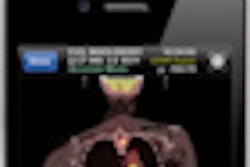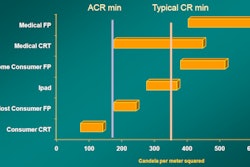CHICAGO - While medical-grade displays offer a longer life span and superior consistency over time, the growing capabilities and significantly lower cost of consumer displays may offer a more compelling PACS display alternative, according to research presented at the 2007 RSNA meeting.
Consumer displays "are ten times cheaper and more easily procured and replaced," said Dr. David Hirschorn of Massachusetts General Hospital in Boston. Hirschorn discussed his two years of experience with using consumer displays for PACS during a scientific session Tuesday.
In terms of the issue of luminance degradation, medically marketed displays come with lots of "overhead," or extra brightness capability, and a feedback mechanism that allows them to maintain a constant light output. This is typically a brightness of 400 to 500 cd/m² over the life of the display, about five years, Hirschorn said.
"Over the lifetime of the display, the light output is constant, and that's wonderful," he said.
Consumer displays, however, have no overhead and no feedback mechanism. As a result, light output slowly decays over time, Hirschorn said.
"We found in practice that most of our displays start out at about 450 cd/m², and fall to about 375 cd/m² over about 18 months," he said.
The American College of Radiology (ACR) still says 170 cd/m² is the minimum standard, "but no clinical radiologist wants to read a chest x-ray at 170," Hirschorn said. "We've found that if you give us more light, we will see more. We will pick up more pulmonary nodules, we will see more pneumothoraces."
As a result, the useful life for these displays for radiography was about 18 months, he said.
In addition to its effect on white level, luminance degradation would seem to have an effect on calibration precision, as the DICOM part 14 grayscale display function is a nonlinear function of the display's black and white levels, he said. As such, target values should change as the display gets dimmer and the calibration should be "thrown off."
In practice, however, the divergence from the curve was not significant within these limits, Hirschorn said.
The researchers have noted a few artifacts from their use of consumer displays, including burn-in. That effect has been reversible after leaving the monitor off for a week, he noted.
Another effect, called yogore, consists of broad smudgy bands on the screen. This is not reversible, however, and the manufacturers replaced the units, Hirschorn said.
Medically marketed displays offer the advantage of ease of calibration and conformance checking, consistent light output, and a slightly higher number of pixels (3 megapixels versus 2.3 megapixels), Hirschorn concluded. Consumer-marketed displays, however, offer color (although high-brightness displays are also available now from medical display vendors), are significantly cheaper, and easier to purchase and replace, he said.
"You're talking about $600 for a monitor that lasts 18 months," Hirschorn said. "Even if I throw it out every year, I still don't come anywhere close to spending the amount of money that I would spend on a medically marketed display."
By Erik L. Ridley
AuntMinnie.com staff writer
November 27, 2007
Related Reading
DICOM-compliant displays aid CR/DR exposure control, July 17, 2007
Building the Best RFP: Part 2 -- Display software, July 16, 2007
Consumer color display may be suitable for radiographic image review, November 30, 2006
Frost forecasts strong growth in European display market, September 22, 2006
NEMA publishes new FFDM QC standards, August 15, 2006
Copyright © 2007 AuntMinnie.com




















